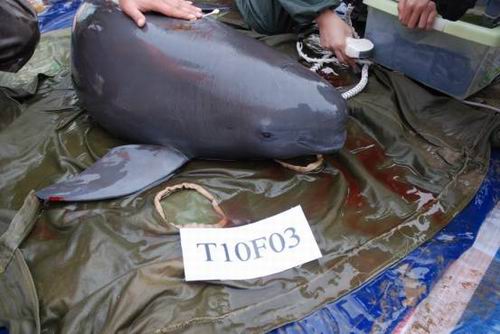|
Ex-situ Conservation of Yangtze Finless Porpoises Goes well
in Tian-e-zhou Baiji National Reserve
 |
| IHB researchers performed routine physical examination on a captured Yangtze finless porpoise. |
Since the ecological environment of Yangtze Basin can hardly have any distinct improvement in a relatively short period of time, ex-situ conservation is still one of the most effective measures to save the Yangtze finless porpoises. Situated in Shishou, under the administration of Administrative Department of Fisheries Management of Hubei Province,Tian-e-zhou Baiji National Reserve is China’s first national reserve built up to conserve Yangtze River dolphin, or Baiji and Yangtze finless porpoises.
The Yangtze finless porpoise in Tian-e-zhou Baiji National Reserve is the only natural population which keeps increasing in recent years. Its population size reached about 30 in 2007, signaling a preliminary success accomplished in the ex-situ conservation of Yangtze finless porpoises. Nevertheless, the severe icing and snow disaster occurred in South China in the spring of 2008 caused great damages to the bodies of Yangtze finless porpoises, and even caused death to some individuals. With the purpose of obtaining data on the population structure and recovery of health status
 |
| A Yangtze finless porpoise which suffered from the extreme weather in the spring of 2008 gradually recovered. |
of the Yangtze finless porpoises in Tian-e-zhou Baiji National Reserve, a 20-member research team consisting of researchers and postgraduates from the Research Group of Conservation Biology of Aquatic Animals at Institute of Hydrobiology, Chinese Academy of Sciences (IHB), and Dr. Tadamichi Morisaka from the University of Tokyo, together with administrative staffs of Tian-e-zhou Baiji National Reserve and local fishermen conducted a wide-range capture of Yangtze finless porpoises in Tian-e-zhou Baiji National Reserve during Oct. 28th and 30th. They performed a series of research activities including routine physical examination, B-ultrasonic check-up, PIT label embedding and acoustic tracking etc. Biological samples such as blood, milk and stool were also collected for the follow-up genetic, physiological and nutritional analysis.
 |
| A newly born female Yangtze finless porpoise. |
The investigation indicates that those Yangtze finless porpoises which suffered from the extreme weather in the spring of 2008 gradually recovered. Bruises and scars are hardly spotted. This recovery status somewhat shows the accomplished achievement ever made since the rescue action, which geared up in April 2008 by IHB and the Tian-e-zhou Baiji National Reserve Administrative Committee, took place. In addition, the majority of Yangtze finless porpoises which are captured this time are physically strong. Their fatness and weight are far better than the individuals living in Poyang Lake, showing that fishery resources are abundant in Tian-e-zhou Baiji National Reserve. What is more pleasing is that over the past three years, 10 juvenile Yangtze finless porpoises, including 8 females, have been born and survived here. The sex ratio thus approaches to the ideal value of 1:1. Among the captured eight mature female finless porpoises in 2008, five were pregnant, and among the captured six mature female finless porpoises this time, four are pregnant and two are lactating, these investigation results indicate that the pregnancy rate of female finless porpoises in Tian-e-zhou Baiji National Reserve is very high. It is believed that as the number of female individuals keeps increasing, the population of Yangtze finless porpoises in Tian-e-zhou Baiji National Reserve will grow quickly in the next several years, thus forming a relatively large and stable ex-situ conservation population.
|




